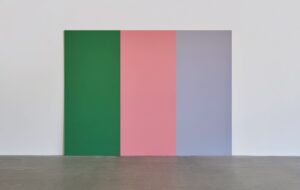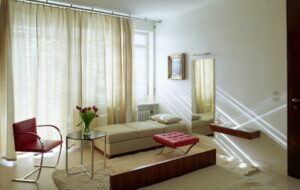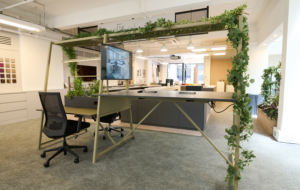


words Justin McGuirk
Yves Béhar likes the word “story”. He uses it again and again when talking about his work. Where most industrial designers invest their attention in materials and form, Béhar tries to see his products in terms of a narrative.
This could just be a line he feeds journalists, or an abstruse way of describing what, really, all designers do. But whatever Béhar’s methodology, it’s working.
Béhar, who is from Switzerland but is based in San Francisco, has emerged as one of the industrial design world’s most protean talents. His practice, Fuseproject, has designed products for a bewilderingly diverse range of brands, from Hewlett Packard and Toshiba to Nike, Mini and sandal-maker Birkenstock. It is Béhar’s ability to dip into the realms of these global giants and produce not just a one-off product but a one-off product with the potential to kickstart the evolution of a brand that makes him unusual.
However, the 38-year-old’s brilliant young career in corporate design seems trivial compared with the non-profit venture he is currently engaged in, which may be one of the most significant design projects of our time. The One Laptop per Child scheme aims to distribute notebook computers among the world’s poorest children. Béhar was commissioned to design a $100 laptop, and even though the final product has yet to be unveiled, seven million of them have already been ordered.
We meet at the Paris Theater, an art deco former cinema in Miami. It’s December, and as part of the city’s first international design fair crystal brand Swarovski is exhibiting its latest set of designer chandeliers. Béhar has designed one called Voyage. A looping Moebius strip, it’s a version of a much larger piece he made for JFK Airport in New York. But it’s too hushed and atmospheric in here for an interview.
We walk out along Washington Avenue towards the Wolfsonian Museum, one of America’s most important design institutions. On the way we stop at an eccentric South Beach Deco building with a waterless fountain that would make a good backdrop for a portrait, so Béhar – a dedicated windsurfer, skier, snowboarder and all-round outdoor sports enthusiast – leaps up onto one of the water platforms. With his blond curls he looks part surfer dude and part pageboy from a Renaissance painting.
In one of the Wolfsonian’s conference rooms, somewhere above a collection of design objects from the height of the industrial age, we start to talk about Béhar’s work. “I guess for me the starting point is always an element of storytelling,” he says. It is worth pointing out that Fuseproject’s slogan – or mantra – is “design brings stories to life”, and its logo is a ball of unravelling yarn. “We do presentations that walk our clients through who they are and what’s going on in the world and how we want to make them relevant in the world.” It sounds like self-help branding. Except that Béhar sees himself as operating above the cynical rules of the global image economy. “We’ve spent the last 25 years being dominated by advertising,” he says. “All the energy and all the fun in who a company is and how it connects to the consumer has been followed through advertising and marketing. In many cases the product is really seen as secondary.”
This truism goes some way to explaining Béhar’s spiel: the “story” is about how to give the consumer something they would really want rather than something they just think they want based on the style content of its marketing.
In some ways, talking about Béhar’s work is not an easy thing to do. There are few obvious threads running through his disparate array of products. There is no favoured medium or subject. He designs computers, furniture, phone headsets, clothes, shoes, perfume bottles and underwear packaging. Béhar is somewhere between a 21st-century corporate hired gun and a 19th-century dilettante. His ability to cross disciplines and media has become his calling card. One could draw parallels with Australian designer Marc Newson, who also designs everything from furniture to sportswear, but Newson is a formalist. There is no signature Béhar style. In an age when everyone, the designer included, is effectively building brand recognition, Béhar’s anonymity is what makes him interesting.
One point of entry into his work stands out: technology. Béhar’s method of trying to bring the product back to the fore is by making it more useful, and an instinctive use of technology is often his tool. For instance, Fuseproject designed a hooded-top for Italian cashmere label Lutz & Patmos that is made of Teflon-coated cashmere, so that it is both soft and waterproof. For Aliph he designed a mobile phone headset called Jawbone that cuts out background noise, which it does by sensing facial movements to distinguish when the user is speaking. In a nod to design’s current obsession with customisation, Béhar produced the Learning Shoe, a rubber slipper with a microchip that collects information about your feet and walking style that can be used to make your perfect shoe. It sounds ingenious, but Béhar has also designed much less clever footwear, such as his colourful Birki for Birkenstock. This rubber clog with no air holes made people’s feet so sweaty that the shoe had to be redesigned with holes, and yet it was still a success, giving the favoured footwear brand of the hippy traveller a complete image overhaul.
Half German and half Turkish, Béhar was born and raised in Lausanne, Switzerland. At 22 he went to study at the Art Center College of Design in Pasadena and then started working for two major design agencies, first Frog Design in Silicon Valley and then Lunar in San Francisco. It was the dotcom boom and he was designing products for computer giants such as Apple and Hewlett Packard. But Béhar didn’t find the design culture particularly fulfilling. “I basically became a little bit discouraged about how design was just about cranking out products for marketing departments in computer companies that don’t have a strong internal culture.”
In 1999 he set up Fuseproject, and one of his intentions was to put what he calls the “humanity” back into technology products. “There is so much promise in technology if it’s done in a way that’s intuitive and really considers the human – I call it sometimes technology with humanity.” There is a trace of French in his American accent, and he occasionally slips into French sentence structures. “I’ve been working on cell phones for example, and I always ask people, ‘Do you want a smart phone or a stupid phone?’ And everybody wants a stupid phone. If somebody tells me this is ‘smart’ I’m going to think it’s difficult … Most of the technology products we have right now make our life more difficult.”
Béhar is particularly interested in our tactile relationship with products. This concern can be seen in his Transformer laptop for Toshiba, in which the keyboard folds back as a stand for the monitor so that it can be an entertainment screen, or his packaging-free packaging solution for Devo underwear, which involves spraying the pants with a stiffening layer of corn starch that comes out in the wash. But Béhar is not just a clever functionalist: his Inner Light, a self-standing loop of light, has a kind of poetry and reads like a witty, computer-age reworking of Castiglioni’s 1960s classic, the Arco lamp.
One of the striking things about Béhar, who is clearly trying to see products from outside the blinkered corporate imagination, is that he nevertheless walks a flawlessly diplomatic corporate line. He decries the idea of authorship in favour of the idea of collaborating with his client, which is perhaps why he can infiltrate global brands with massive in-house design departments. “I think the best work you see out there is these collaborations between visionaries in business and visionaries in design. How much of Apple is Steve Jobs and how much is the design team? Well, probably fifty-fifty. If anything, I would say we need more Steve Jobses than we need more design.”
For his new laptop design, one collaboration proved critical, that with the renowned computer scientist Nicholas Negroponte. Negroponte, until recently chairman of the Massachusetts Institute of Technology’s Media Lab, approached various designers with a visionary scheme that he was calling “One Laptop per Child”. The notebook computer was to cost $100 and the aim was to manufacture 100 million of them to be distributed among the world’s poorest children. Negroponte chose Béhar’s design, and his faith in it is such that he has now resigned from MIT to concentrate on the OLPC venture.
“My key concern was to build something regionally non-specific,” says Béhar. “It needs not to feel like it’s from the West. It’s a solution for developing countries with a unique feel specific to children.” The machine, which is cased in rubber, will be customisable so that children can colour, decorate or accessorise them as they want. It will also keep out the elements, with no exposed connections permeable to water or dust – Béhar describes it as “sealed like a piece of luggage”. To keep it cheap, the specifications have been pared down – the machine will only have a 1GB hard drive and will avoid bloated software applications, running on the simple and efficient Linux operating system – but it will have a full colour screen. The most unusual aspect will be its variety of power sources, which range from batteries and solar panels to a hand crank.
The educative potential of the OLPC scheme is breathtaking. The machine contains a more powerful than average Wi-Fi antenna so that children can communicate and share material on a single network. “Say a school district in a city buys a hundred thousand computers, they can all connect together on a mesh network,” says Béhar, “which means only one child needs to be connected to the web or a network, so you don’t have the constraints of not being connected in your own classroom or environment. It allows for the downloading of lessons and texts, and communicating between kids and cultures.” Negroponte has already taken seven million orders for the notebook from the governments of Egypt, Nigeria, Thailand, India, China and Brazil.
When we meet in December, Béhar’s learning tool for the developing world is still a big secret. Not yet the important cultural figure, he is still the emerging product designer who, in his combat trousers and pink-flecked sneakers, is standing in the Wolfsonian’s gift shop squeezing a stress ball in the shape of a human head that he’s found on one of the shelves. “I was talking to a fashion designer about this a long time ago,” he says out of nowhere. “We try to communicate through our work but it’s maybe a sideways, complicated way to communicate – you know, through objects. But somehow that’s the path we chose.”















